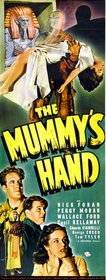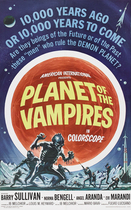Our editor-in-chief Nate Yapp is proud to have contributed to the new book Hidden Horror: A Celebration of 101 Underrated and Overlooked Fright Flicks, edited by Aaron Christensen. Another contributors include Anthony Timpone, B.J. Colangelo, Dave Alexander, Classic-Horror.com's own Robert C. Ring and John W. Bowen. Pick up a copy today from Amazon.com!
The Mummy's Hand (1940)
In the 1940s, Universal Pictures sought to bring another horror franchise to life (as it had with Dracula and Frankenstein previously) with the production of four films based off their 1932 film, The Mummy. After a rushed shooting schedule (less than a month) and last minute editing[1], the first of these films was released. Titled The Mummy’s Hand, the film is a less suspenseful reworking of the deliberately slow-paced psychological thriller that served as the framework for the original Mummy, opting instead for an over-the-top action and adventure flick with bits of supernatural elements tossed in to maintain a swift — and oftentimes erratic — pacing.
At the forefront of this action/adventure epic are archaeologist Steve Banning (Dick Foran) and his partner, Babe Jenson (Wallace Ford), who seeks the tomb of the Egyptian Princess Anaka. Funding for this expedition comes from an unlikely source, a magician named The Great Solvani (Cecil Kellaway) and his daughter and assistant, Marta (Peggy Moran). Unbeknownst to our heroes, the tomb is being guarded by a high priest, Professor Andoheb (George Zucco) and Kharis the Mummy, who is under the priest’s control.
Modern reviews and readings on The Mummy’s Hand dismiss the idea that the film is a direct sequel to the 1932 original, citing its new characters and differentiating plot. However, the basic outline of The Mummy still exists in some regard, most notably in the flashback sequences that explain the origin of Kharis the Mummy (named Im-ho-tep in the 1932 film). Ironically enough, these scenes have been unceremoniously lifted from the original Mummy with matching inserts of actor Tom Tyler (Kharis) replacing Boris Karloff (an uncredited Karloff can still be seen in the long shots, however).
As straightforward (and familiar, to a certain degree) as the plot is, it does suffer from some erratic pacing as a result of its supernatural elements, the foremost marketing point of the movie at the time of its release. In the original 1932 film, the Mummy arises from his tomb after a character reads from an ancient scroll; in this version, it is the high priest Andoheb that brings Kharis to life, using a liquid concoction made from tana leaves, giving the priest total control over the monster. It is a foreign concept to those familiar with the original film and Hand must spend a subsequent amount of time explaining these unfamiliar elements. In doing so, the pace of the film slows down and becomes inconsistent with the rest of the film, which moves along quite briskly and with few hitches.
Screenwriter Griffin Jay has implemented so much quick-draw dialogue between its two main characters that even a slight explanation seems to be taking too much time out of the film. Consider a scene at the beginning of the film when the audience is first introduced to Steve and Babe as example of this swift back-and-forth dialogue that sets the overall pace of the film:
Steve: “You hear from that blonde in Brooklyn?”
Babe: “Oh, you know she won’t write me.”
Steve: “Won’t or can’t?”
Babe: “I told you she was a college girl.”
Steve: “Sure, Stacy Beauty College.”
This idea of a faster-moving film carries through in the well-choreographed action sequences as well. Just after Steve, Babe, and Solvani have made their arrangements inside a bar, a cluster of Egyptians, obviously followers of the evil high priest, approach their table and a knock-down, drag-out bar-room brawl ensues. Not only is the believability thrown out the window (could these three bumbling heroes really hold their own?) but a few villains are as well. It comes as no surprise that a film that favors its action-adventure side over its suspense-side would have a scene like this one, though this is not to admit that the film has no suspense whatsoever.
George Zucco’s over-the-top performance as the high priest Andoheb is one of the more suspenseful and chilling portrayls in the film. Much akin to Karloff’s performance as Im-ho-tep’s alter-ego Ardeth Bay in The Mummy, Zucco delivers his lines with same poignant pitch that seems to feed chills directly into the audience. Zucco also manages to raise a bit of suspense in the film with the touch of searing tenacity that he brings to the role of a man in control over the film’s monster; much like the characters, the audience is never sure what Andoheb is capable of, or when or where he’ll unleash Kharis. Zucco’s performance allows the Andoheb character to thrive as a formidable villain in not only this film, but in two of its sequels, The Mummy’s Tomb and The Mummy’s Ghost as well.
There is a comparatively weak performance here from Tyler as Kharis, whose on-screen presence feels severely diminutive next to the commanding Zucco. Tyler’s interpretation of the Mummy character is much too bland when compared to Boris Karloff’s work in the original film, or even Lon Chaney’s in The Mummy’s Tomb. Tyler lurches through his scenes (of which there are few) with a limp and his head hung to the floor, giving the outward appearance not of a monster, but of a coward. Karloff and Chaney’s performances as mummies (as well as Ardeth Bay, in Karloff’s case) are much more confident — their heads are held high and their bodies kept stiff — and the resulting performances accent their respective films’ suspense. Here, Kharis never feels like a real threat to the characters, and as a result, the audience feels the same. The absence of the Mummy as a formidable threat serves as a severe loss to the film.
The Mummy’s Hand is a product of bad timing. Its release a mere eight-years after the original has caused it to be confused as a sequel, an idea that might cause disappointment among viewers. It is an intriguing thought to have a faster-paced send-up of the original film (as the 1999 film The Mummy would later do), but the focus on the action-adventure elements rather than suspense in The Mummy’s Hand leaves much to be desired. This is a much more entertaining film that the original to be sure, but it is a much less suspenseful one as well, so does that make it better? No, for the simple fact that this film adds little to the legacy of the Mummy character, which I believe to be the intent of Universal when making this film. Now, give me a film that explores the legend of Andoheb and we just might have something more suspenseful and worthy of the Mummy name.
[1] Shooting began in May 1940 and ended late June 1940. Credit: Universal Horrors by Weaver, Brunas & Brunas








